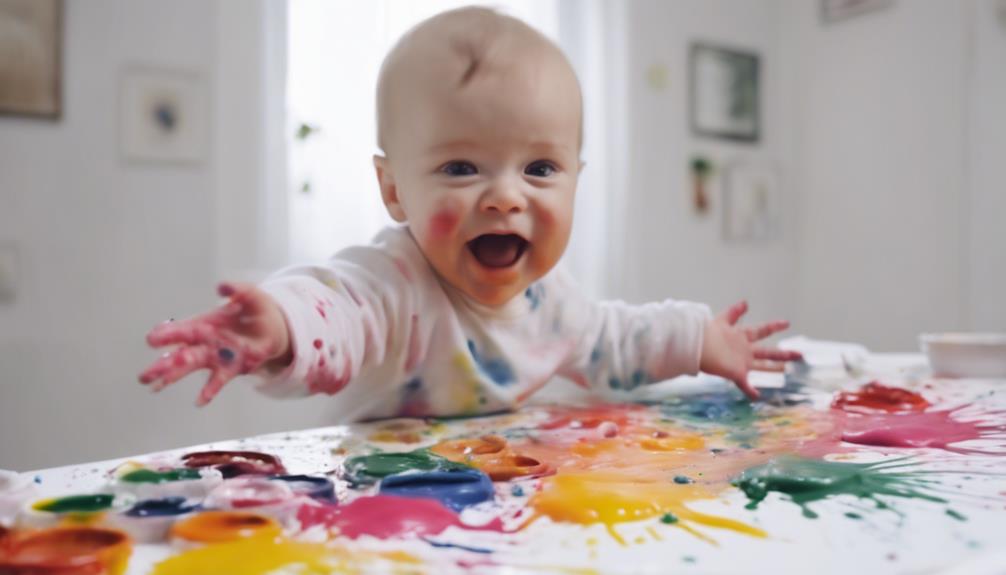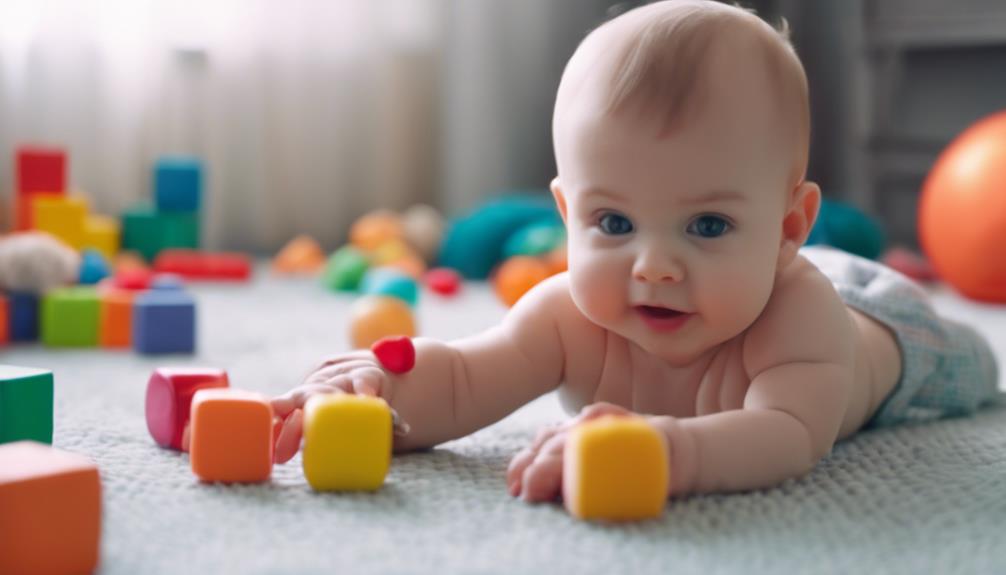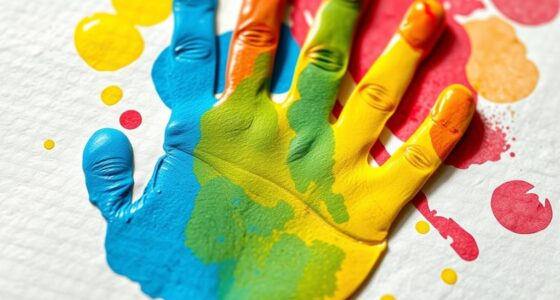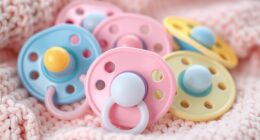Engage in baby finger painting as a valuable developmental activity that boosts sensory skills, creativity, and cognitive growth. Make sure to use non-toxic finger paint, a waterproof smock, and an easy-to-clean painting surface. Use a washable tablecloth, non-toxic paint, and waterproof smocks for setup. Offer a safe and colorful finger paint made of cornstarch, water, and food coloring. Tailor activities for different ages to encourage creativity and self-expression. Clean up with warm, soapy water, baby wipes, and disposable table covers. Explore handprint ducks, color recognition, and imaginative play. Strengthen bonding and foster fine motor skills development. Uncover additional benefits beyond just the enjoyment and messiness of finger painting.
Key Takeaways
- Promotes sensory development and creativity in children.
- Enhances fine motor skills and cognitive growth.
- Fosters emotional expression and caregiver bonding.
- Provides a fun and messy artistic outlet for kids.
- Encourages imaginative play and color exploration.
Benefits of Baby Finger Painting
Engaging in baby finger painting offers numerous benefits that aid in your child's sensory development and creativity. Through this colorful and tactile activity, your little one can enhance their fine motor skills as they grip and move their fingers to create beautiful masterpieces.
The act of finger painting allows for sensory exploration, as your baby feels the textures of the paint and paper, stimulating their senses and cognitive development. Additionally, messy play, like finger painting, has been shown to promote brain growth and emotional expression in infants.
As you bond with your baby during finger painting sessions, you aren't only creating memories but also fostering a strong connection through shared experiences. Dr. Smith, a pediatrician, emphasizes the importance of bonding activities, stating, 'Engaging in creative activities like finger painting can strengthen the caregiver-child relationship.'
This shared creative process introduces your baby to a world of colors, shapes, and textures, laying the foundation for early learning and self-expression.
Necessary Supplies for Finger Painting
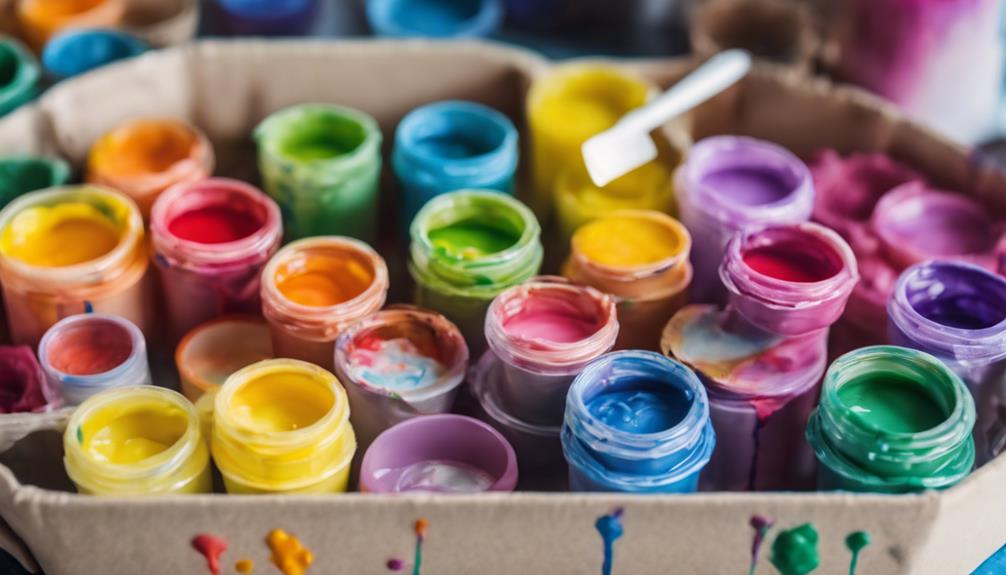
To begin baby finger painting, gather essential supplies such as finger paint, a waterproof smock, an easy-to-clean painting surface, cleaning materials, and towels.
When selecting finger paint for your child, opt for non-toxic and washable options to guarantee safety and easy cleanup. A non-toxic formula is vital to prevent any harm in case your baby decides to taste the paint during the creative process.
The waterproof smock or apron will help protect your child's clothing from getting messy, allowing them to fully immerse in the finger painting experience without worry. An easy-to-clean painting surface is recommended to contain the mess and simplify the post-activity cleanup.
Having cleaning materials like sponges and soapy water readily available will ensure that any spills or messes can be swiftly taken care of, making the finger painting session a fun and stress-free activity for both you and your baby.
Setting Up the Finger Painting Area
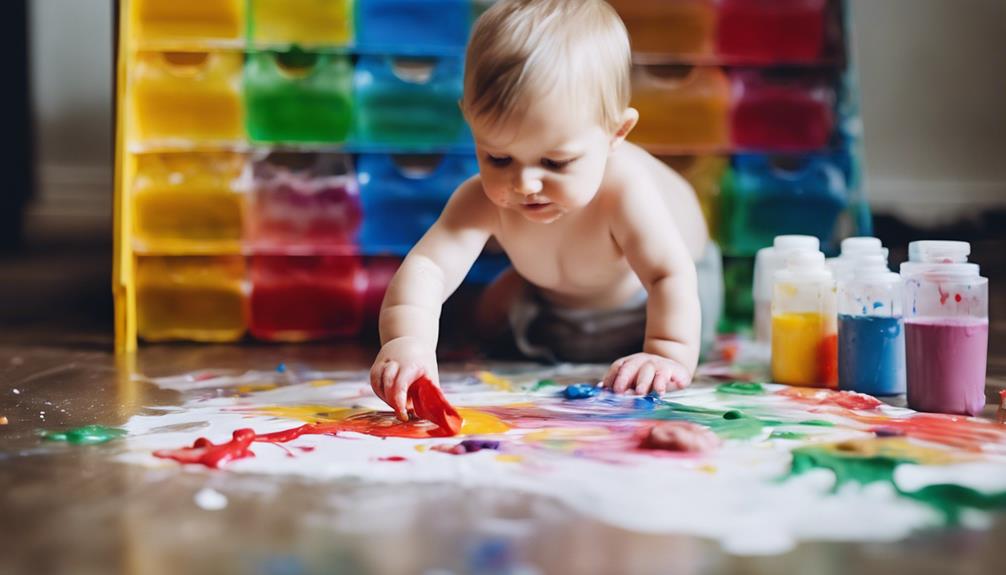
Consider covering the painting area with a washable tablecloth or plastic sheet to safeguard surfaces from paint stains.
When setting up the finger painting activity for your children, it's important to use non-toxic paint to guarantee their safety. Provide them with waterproof smocks or old clothes to protect their outfits from getting messy.
Additionally, it's advisable to set up a designated area specifically for finger painting. This will help contain the mess and make cleanup easier afterward.
Using finger paint paper or thick paper can absorb excess paint and prevent it from seeping through onto other surfaces.
Remember to have easy access to water and soap nearby for quick cleanup post the art session.
Step-by-Step Finger Painting Guide
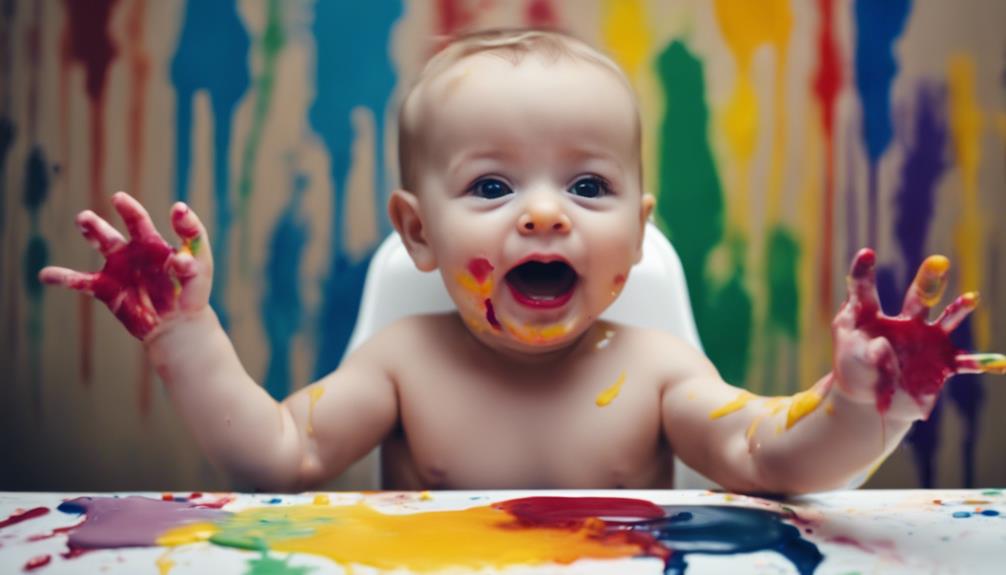
To guide your baby through a delightful finger painting experience, start by preparing a safe and colorful finger paint using simple ingredients like cornstarch, water, and food coloring. This edible finger paint guarantees a fun and secure activity for children, especially toddlers, who are enthusiastic to explore through touch and creativity.
The benefits of finger painting go beyond just a messy playtime; it helps in sensory development, fine motor skills, and self-expression.
Secure a mess-free painting session by covering the area with a protective surface and using non-toxic paint that's easy to clean. Engage with your baby during the activity to promote bonding and encourage their artistic exploration.
Adapting Finger Painting for Different Ages
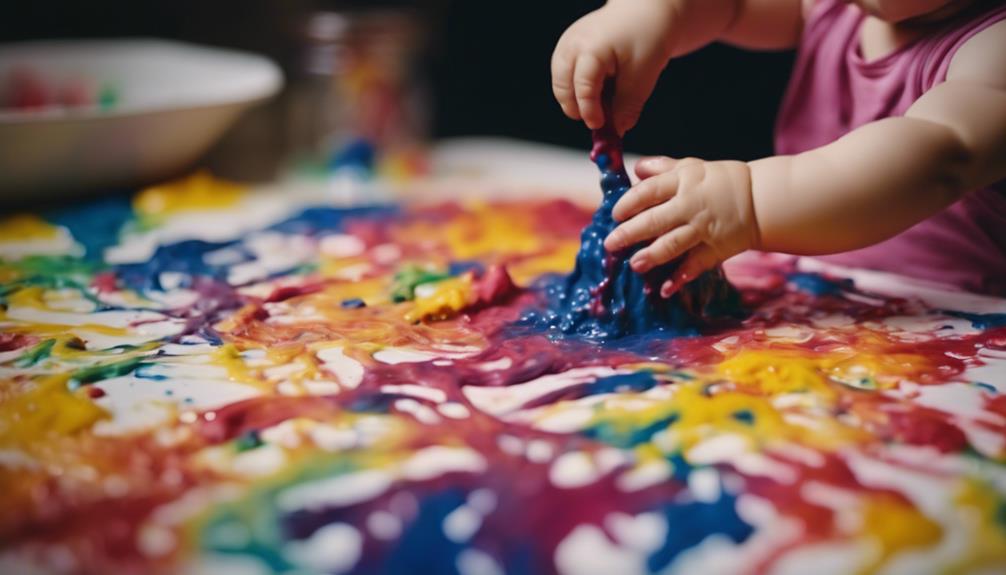
Adjust finger painting activities to suit the age of the child, ensuring they can engage with the art at their own developmental level. For younger children, focus on simple activities that promote sensory play and fine motor skills. Encourage them to explore the paint with their fingers, experiencing different textures and colors. This helps in fostering creativity and early artistic expression. As children grow older, introduce more complex finger painting tasks that involve color mixing, patterns, and detailed artwork. This challenges their creativity and allows for further development of fine motor skills.
Consider the following table to adapt finger painting activities for different age groups:
| Age Group | Recommended Activities |
|---|---|
| Younger Children | Focus on sensory play and color exploration. |
| Older Children | Introduce color mixing, patterns, and detailed artwork. |
Adapting finger painting for different ages not only caters to their developmental stage but also allows children to engage in a fun and educational art experience that promotes creativity and self-expression through the medium of paint.
Homemade Finger Paint Recipe
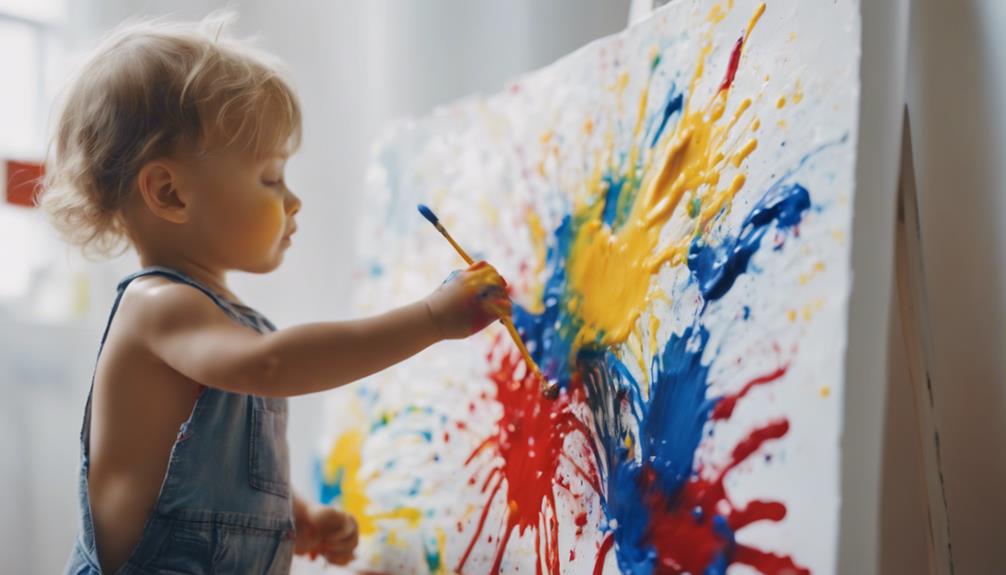
Creating your own homemade finger paint is a simple and safe way to provide children with a non-toxic artistic experience. By using ingredients like cornstarch, water, and food coloring, you can easily whip up a DIY paint recipe that's perfect for babies and toddlers.
Mixing cornstarch with boiling water forms a smooth paste base for the finger paint, ensuring a safe and non-toxic option for your little ones. Once the mixture has cooled, adding food coloring allows for a wide range of vibrant colors for your young artists to enjoy.
This homemade finger paint recipe isn't only cost-effective but also promotes sensory play and creativity in children. It offers a hands-on experience that engages different senses and encourages exploration through art.
Fun Finger Painting Activities for Kids
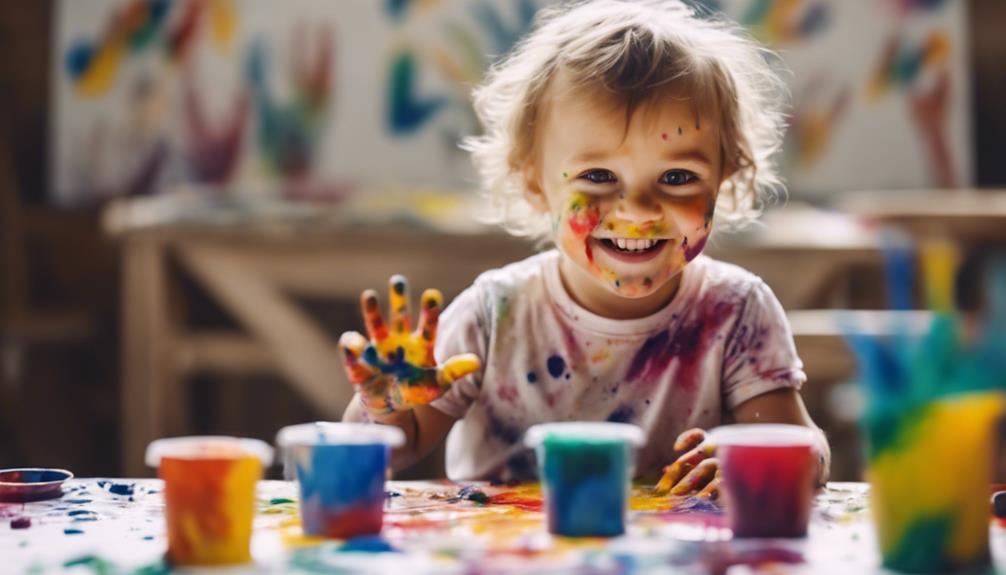
When it comes to fun finger painting activities for kids, there are plenty of colorful ideas to explore.
Engage your little ones in creating adorable handprint ducks and chicks or designing cute snowmen using their fingertips.
Encourage imaginative play with projects like footprint rockets and fingerprint fall trees, all while teaching them color recognition and pattern creation in a mess-free way.
Colorful Finger Painting Ideas
Get ready to explore a variety of vibrant and exciting finger painting ideas that will keep your kids entertained and engaged for hours. Finger painting isn't just a fun activity for babies; it also encourages creativity and sensory exploration.
Here are some colorful finger painting ideas to try with your little ones:
- Edible Finger Paint: Use safe and edible finger paints for worry-free creativity.
- Primary Colors: Introduce the primary colors – red, blue, and yellow – for mixing and experimenting.
- Mess-Free Techniques: Explore mess-free finger painting techniques to enjoy the activity without the stress of cleaning up.
- Unique Artwork: Encourage your children to explore different painting techniques to create one-of-a-kind artwork.
- Fine Motor Skills Development: Finger painting provides a fun way for kids to learn and develop their fine motor skills while having a blast.
Let your kids immerse themselves in the world of colors and textures with these exciting finger painting ideas!
Mess-Free Painting Techniques
Explore fun and mess-free finger painting techniques for kids by incorporating clever strategies to minimize clean-up and maximize creativity.
To keep the mess contained, secure a piece of construction paper with painter's tape and place it inside a sealed storage bag with edible finger paints. This allows your child to freely paint without worrying about spills or stains on furniture.
For added fun and texture, offer various objects like brushes, sponges, or even fruits for unique patterns. Experiment with cardboard stencils or roll toy car wheels in paint to create shapes and designs on the paper.
Encourage your child's imagination and artistic exploration while staying close to prevent any potential messes. Engaging in the activity together not only enhances bonding but also promotes sensory play and fine motor skills development.
Cleaning Up After Finger Painting
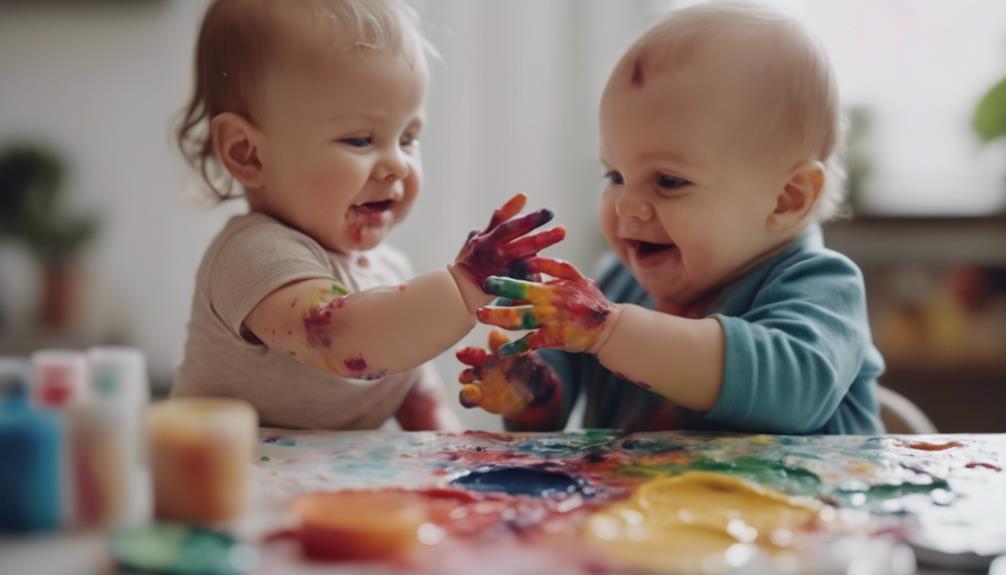
Consider incorporating these steps into your routine for efficient cleaning up after finger painting.
- Use warm, soapy water and a gentle scrub to clean hands and surfaces after finger painting.
- Wash clothing immediately after painting to prevent stains from setting.
- Consider using baby wipes to quickly clean hands and faces before a more thorough wash.
- Have a designated cleanup area with towels and wipes to make the process efficient.
- Use disposable table covers or newspapers for easy cleanup of painting surfaces.
After the artistic fun with finger painting, it's essential to tackle the cleanup effectively. Begin by gently scrubbing hands and surfaces with warm, soapy water to remove paint residue. Remember to promptly wash any clothing to prevent stains from becoming permanent.
Utilize baby wipes for a quick cleanup on hands and faces before proceeding with a thorough wash. Designating a specific cleanup area equipped with towels and wipes streamlines the process. Additionally, employing disposable table covers or newspapers protects surfaces, making cleanup a breeze.
Frequently Asked Questions
How to Do Mess Free Painting?
To do mess-free painting, secure paper with painters tape and use a sealed storage bag filled with finger paint. Let toddlers mix colors inside the bag for a clean experience. Tape the bag on a window for a unique backdrop. Easy cleanup – just dispose of the bag after painting.
What Is the Best Age to Start Finger Painting?
You should start finger painting around 12-18 months, progressing to more active engagement at 2-3 years. Early finger painting helps develop fine motor skills and encourages sensory exploration. Remember, supervision is vital for a safe experience.
What Are the Benefits of Mess Free Painting for Babies?
Mess-free painting for babies offers a stress-free way to encourage sensory exploration, creativity, and fine motor skills development. It fosters bonding and allows for controlled messy play. Experience different textures and colors conveniently indoors.
How Does Mess Free Finger Painting Work?
To make mess-free finger painting work, you squirt paint into a storage bag, seal it, secure it with tape over paper, and let kids go wild mixing colors without the cleanup fuss. It's a fun and tidy art experience!
Conclusion
To sum up, baby finger painting is a beneficial and fun activity for little ones to explore their creativity. With the necessary supplies and a designated painting area, children can enjoy the sensory experience of finger painting while developing their fine motor skills.
By following a step-by-step guide and adapting the activity for different ages, parents can create a memorable and educational experience for their children. So, why not roll up your sleeves and let your little artist's imagination run wild with some messy finger painting fun?

